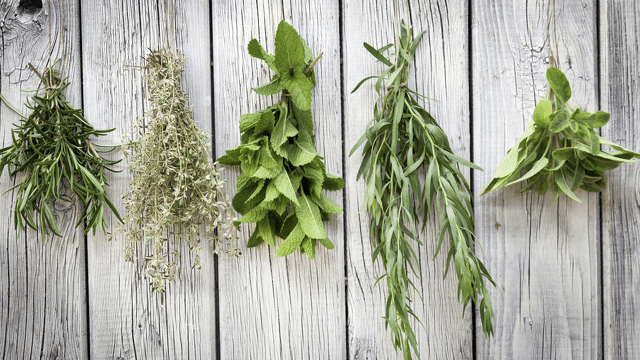It’s easy to love herbs. All those romanticized portrayals of them spell allure, whether it’s in kitchen gardens surrounded by white picket fences glimpsed through back doors, standing at attention in terra cotta pots on a windowsill, or hanging neatly in small tidy bunches drying for later use.
Simply stated, herbs are plants that have become desirable because of their flavor, scent or medicinal qualities. They do double duty in gardens by being some of the more practical plants and not just the pretty faces with showy leaves or blooms.
Adding fresh herbs to favorite dishes really helps to ramp up the flavor and they are not so difficult to grow as annuals or perennials. In various types of cuisines, seeds, flowers, leaves and even their roots can be edible.
Some of the staple herbs to grow often include parsley, sage, rosemary, thyme, basil, chives, dill, oregano, spearmint and tarragon, but there are a myriad of others, from arugula to shallots.
Because there are so many from which to choose, Penn State Extension recommends to think carefully before impulse buying. First, look in recipes and even your current dried herb collection to see which flavors are desired and how they will be used. Then think about how they will be grown, whether in a window box, a pot, or a plot in the garden.
If you are interested in only growing a few varieties of herbs in more limited quantities, purchasing individual plants in pots or inheriting pieces from friends can work well since herbs in containers are often portable, allowing them to spend the summer out of doors.
When picking the perfect plant for purchase, look for sturdy stems, leaves with a good, healthy color, soil that is moist but free of weeds, and a root inspection that shows no pests or pot-bound tendency. Look for descriptions for help with size of containers, such as dwarf size (no more than 18 inches) and root depth.
Next select appropriate containers, since it is good to immediately replant your herb one pot size up to allow for growth. Be creative, using terra cotta, wood, or lined baskets to add pizzazz. Metal containers are also an option. A rule of thumb calls for a 6-inch pot for one plant, 8-inch pot for two plants and a 12-inch pot for four plants. Look for types with similar growing needs if they are to coexist together. Ideas for thematic combinations could include an everyday essential container with sage, cilantro, basil, oregano, parsley and thyme or one for herbal teas with possibilities of lemon balm, bergamot, sweet woodruff, bronze fennel, lemon verbena, Moroccan mint, sweet marjoram or German chamomile.
Prepare the container by adding drainage holes when needed. An unbleached coffee filter or a small piece of newspaper works well to put in the bottom to insure that soil does not leak out when the pot is watered. Use potting mix, and plan to have a tray under the pot to catch water. Any metal container should be sprayed inside with rust-proof paint and can be lined with a thin layer of bubble wrap around the sides to insulate the plants from the metal when they are outside. Tease out the roots of the plant when repotting.
The final step is maintenance. The containers should be initially watered and placed in their chosen location. They then should be kept watered (the amount depends on the plant and location). Do not overwater and check in order to see that the container is continuing to drain.
The pots can be fertilized lightly once a month with slow-release or water-soluble fertilizer.
With herbs it’s a good idea to prune frequently and evenly for harvest. This helps promote growth. Be sure to snip off the flowers of herbs to keep the plant producing leaves and preserve any that won’t be used soon. A tip for summer vacation maintenance is to move the herbs to a place out of direct sunlight and water well or fill a large container with gravel and water and set the plants in there. Of course, you could ask a neighbor to water them, also.
Perennial herbs can be repotted annually by replacing the potting mix and moving them to larger pots, if necessary. Overwintering can be achieved by keeping tender perennials in a cool indoor area with light, turning them once in a while for even light exposure and fertilizing them lightly.
Herbs are used either fresh or dried. An interesting variation on drying that I heard about recently at a Penn State Garden Experience in Manheim was described by Herb Bayshus of Pickleville.
It involved a “clean brown paper lunch bag, paper clip, pen, and a frost-free refrigerator.”
Placing no more than 20-30 large clean leaves or 10-15 stems in a closed bag for two weeks creates dried herbs such as basil, tarragon, sage, lemon balm, parsley, miniature rose petals and scented geraniums with enhanced flavor retention. The pen is for recording the type of herb and date it was refrigerated.
The bag is then kept at room temperature for about a week to be sure it is totally dry; finally, the contents are placed in a brown glass container when kept in the light or clear glass if stored in a dark, cool place.
Whether using herbs to add directly to recipes or using them to make vinegars or butters, they are sure to add plenty of beauty to both the summer garden and table.



